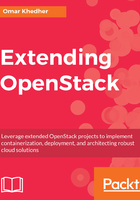
Summary
In this chapter, we briefly introduced the use case of adopting the IaC approach in our OpenStack private cloud deployment. At a very high level, we covered some important topics regarding the new trend of approaching a robust private cloud environment in no time. For this purpose, we started by designing a sample layout from the basic building blocks of OpenStack. We also introduced Ansible as our automation and system management tool for OpenStack. Of course, Chef, Puppet, or Salt are capable of automating such an installation, so feel free to use any software you feel more familiar with. Using Ansible, we took advantage of Ansible-OpenStack playbooks, which we were able to use rapidly to provision a minimal OpenStack environment in simple LXC containers. Finally, we set the first design blocks of our production environment.
In the first chapter, you should have learned a key topic about how you drive your private OpenStack cloud environment to be treated as code. Bear in mind that this approach will open the curtains for your private cloud to add more functionalities and features without the pain of manual configuration or service downtime. The journey will continue to extend what we designed and enlarge the computing power of the current environment, which will be covered in the next chapter.